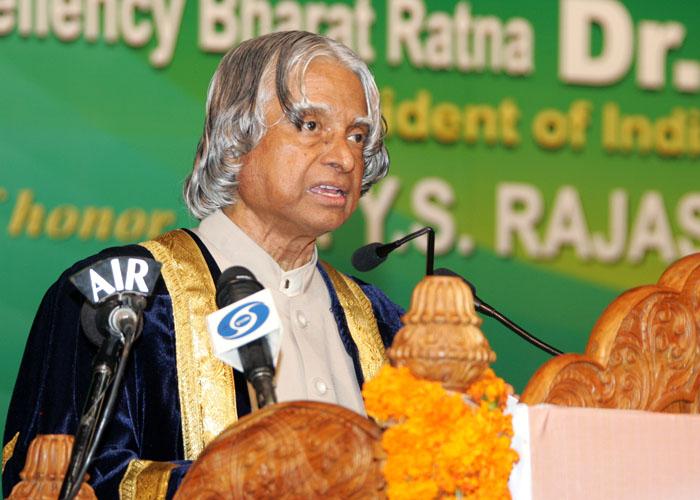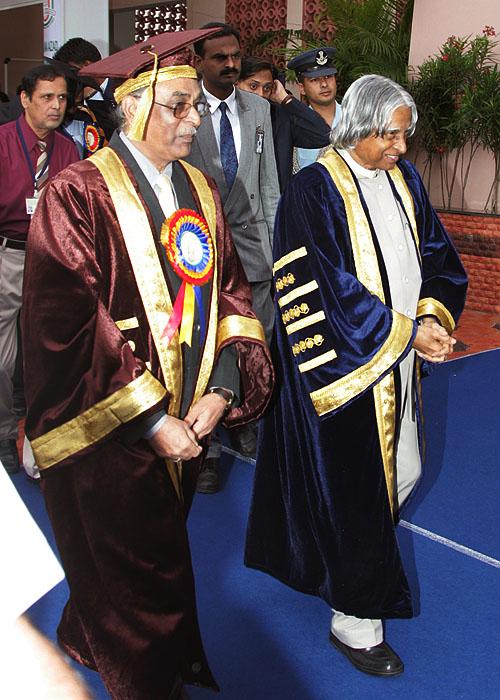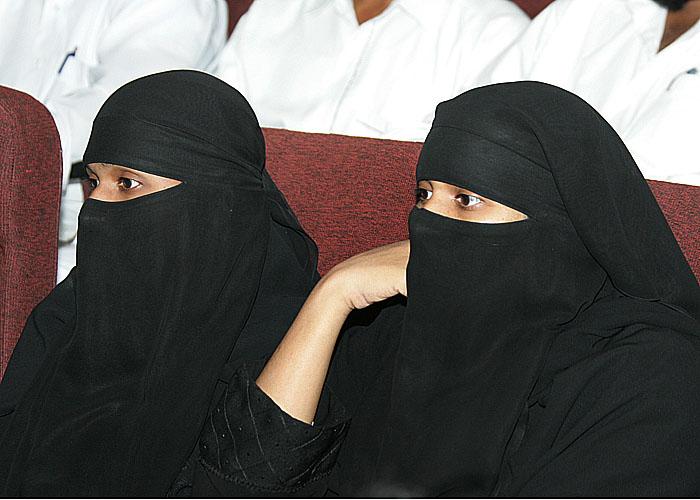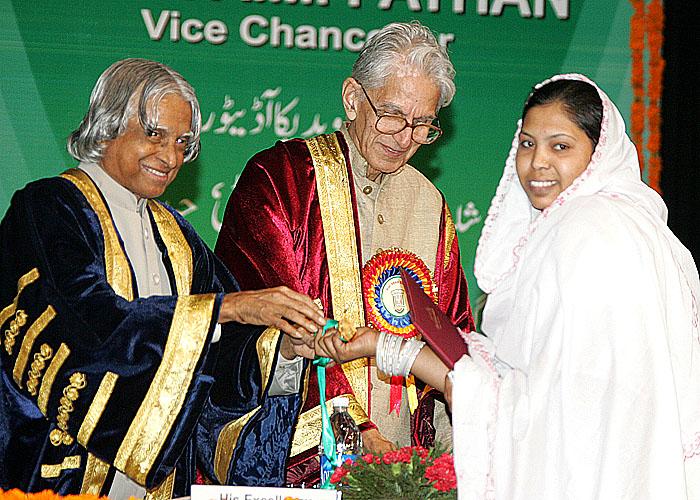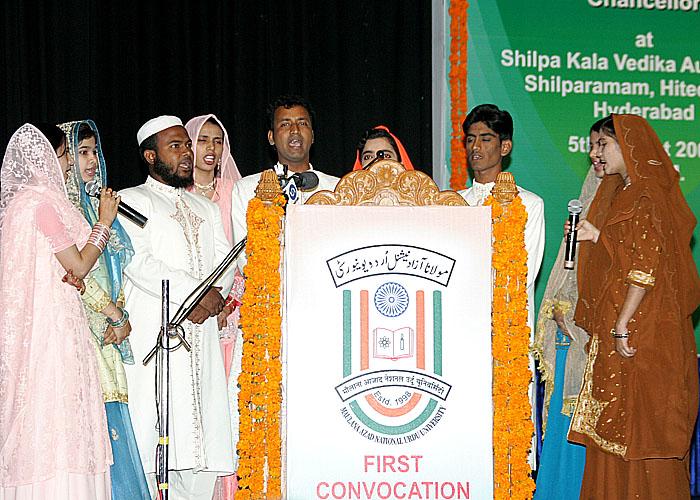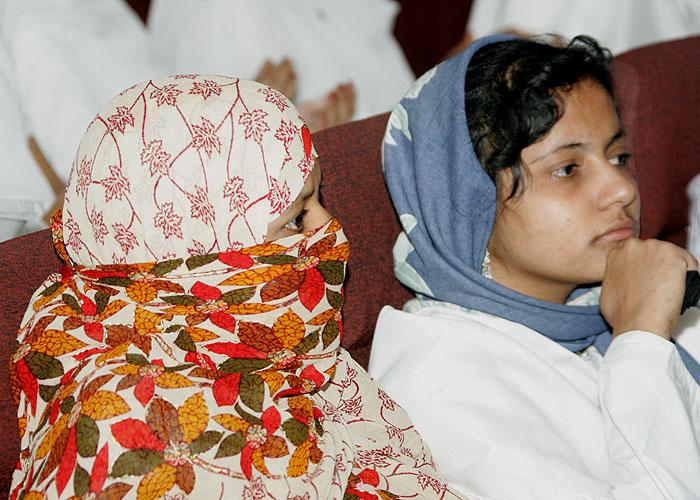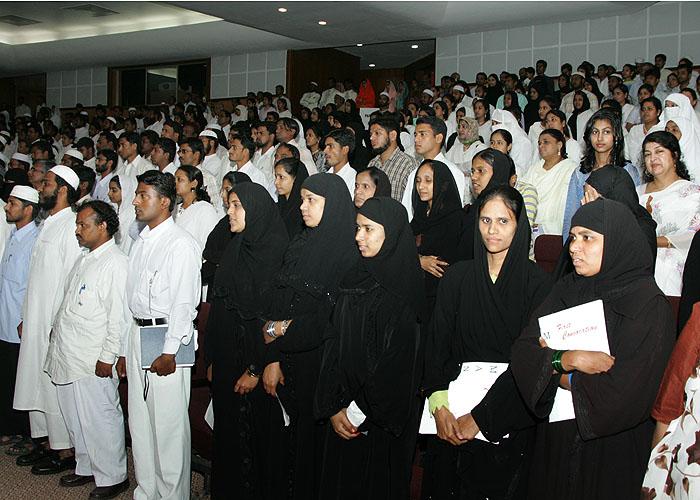Address at the First Convocation of Maulana Azad National Urdu University (Manuu)
Hyderabad : 05-08-2005
Missions for MANUU
I am indeed delighted to participate in the First Convocation of Maulana Azad National Urdu University. I greet the Chancellor, Vice-chancellor, Directors, professors, staff and the members of the study centres for their contribution in shaping young minds in various parts of the country to contribute to the national missions. I take this opportunity to congratulate the University students for their academic performance. I am happy to note that this University is promoting and developing Urdu Language. This enables many students to understand the concept more clearly since Urdu is their mother tongue. It is well known that learning in Mother Tongue is a faster process in any language. Also, it is providing vocational and technical education in Urdu medium through conventional teaching and distance education system. This will enable a large number of women to participate in the education programme and thereby enhancing women education.
The Universities have a major responsibility in nation building, through imparting education to all those who aspire to learn more, by providing education opportunity to students in remote areas in multiple disciplines. In addition, there are many students who interrupt their studies for various reasons. They have a desire to improve themselves and also there are other knowledge seekers. Distance education system provides them good opportunity. Thus the dual mode system of education has a large socio-economic relevance. I understand that during the last two years the University has grown from 68 study centres to over 100 and the intake has gone up from 22,000 to 30,000 students. I was thinking what thoughts I can share with you on this Convocation day. I have selected the topic for discussion "Missions for MANUU".
Enriching the language with science and digital library
Enrich the language through Science: Urdu language is mainly known for literature, poetry and ghazals. Urdu served as a medium of instruction in certain institutions in India and abroad up to university level in many subjects including medical and engineering courses. It is very important to bring a reference book by consolidating all the Urdu text books taught in various Universities and updating it. MANUU has to take up a mission of enriching the Urdu language with the subjects likes Science and technology. In addition there should be exclusive papers for Urdu students in English, Hindi and or regional languages.
Digital Library: The Digital Library of India (DLI) (http://www.dli.ernet.in) has already digitized nearly 2000 books in Urdu consisting of over 4 lakh pages. With this base, MANUU should start a digital library programme in coordination with Prof. N. Balakrishnan, National Coordinator, Digital Library of India. For distance education, this Digital library can be referred during the lectures or transmission of the lessons. Urdu teachers can have a voice overlay on top of the digital library books for learning and teaching purposes. Can the university increase the employment potential through university education?
Employment Generation through entrepreneurship
There has been substantial growth in our higher educational system and we are generating over 3 million graduates every year. Also after 10th class and 10 + 2 nearly 7 million youth seek employment. However, our employment generation system is not in a position to absorb all the eligible candidates. This situation will lead to instability in the social structure. There is a large mismatch between the skills required for the modern economy and the education imparted to most of these students. We need higher education focused on and oriented towards productive employment opportunities. A three pronged strategy is needed to make education more useful, skill imparting and simultaneously create employment potential ? how do we do that?
Firstly, the educational system should emphasize the importance of entrepreneurship and prepare the students right from the college education to get oriented towards setting up of the enterprises which will provide them creativity, freedom and ability to generate wealth. Diversity of skills and perseverance in work makes an entrepreneur. It should be taught to all the students. In addition, college syllabi even for arts, science, and commerce courses should include topics and practical required for entrepreneurship. The university education has to give the confidence to take up small enterprises. Secondly, banks have to be proactive to support young entrepreneurs so that they can acquire earning capacity through the production of innovative products. This may involve taking certain calculated risks, which can be eliminated by making an analysis of successful venture capital enterprises. Thirdly, there has to be an economic pull for human resources; for example generation of marketable products and enhancement of purchasing power among the people. This can come through the implementation of mega programmes such as PURA, Regional linking of Rivers, Infrastructural missions, Power missions and Tourism.
The educational institutions, Government and the private enterprises should become facilitators for creating this entrepreneurship scheme through the support of the banking system and the marketing system. This is one way of reducing the employment gap leading to upliftment of the 260 million people living below the poverty line. This will also enable to raise the living standards of those who are just above the poverty line.
Distance education programme of MANUU is suited for imparting job oriented education as a part of the regular degree course. The students must get a diploma in skill education or entrepreneurship apart from the degree. This will certainly help the students of MANUU to become employment providers instead of becoming employment seekers.
Growth of Knowledge Society
During the last century, the world has undergone a change from agriculture society, where manual labour was the critical factor, to industrial society where the management of technology, capital and labour provided the competitive advantage. Then the information era was born in the last decade, where connectivity and software products are driving the economy of a few nations. In the 21st century, a new society is emerging where knowledge is the primary production resource instead of capital and labour. The Knowledge society is powered by innovative capacity. Efficient utilisation of this existing knowledge can create comprehensive wealth of the nation and also improve the quality of life - in the form of better health, education, infrastructure and other social indicators. Ability to create and maintain the knowledge infrastructure, develop knowledge workers and enhance their productivity through creation, growth and exploitation of new knowledge. These will be key factors in deciding the prosperity of Knowledge Society. Whether a nation is progressing towards the knowledge society can be judged by the way the country effectively deals with knowledge creation and knowledge deployment in all sectors like IT, Industries, Agriculture, Health Care etc. Maulana Azad National Urdu University has a major role to play in transforming the Urdu speaking members of the society into knowledge workers through their dual mode education system. One of the vital needs for the university like MANUU is to set up tele-education delivery system for its distance education programme.
A multi-pronged approach for Tele-Education
A three-pronged approach is essential to make distance education programme viable and a successful proposition through the universal tele-education system to all remote parts of the country. Alongwith Tele-Education System, MANUU needs to get connected to EDUSAT and also generate the Quality Content in Urdu for dissemination to all its constituent centres.
Tele-education Delivery System
I would like to narrate my experience in the development of a Tele-education delivery system. Normally, proper education system has to aim at: a good mathematics teacher teaching mathematics in a remote village in Bheemavaram in AP should be able to teach a number of schools located in different parts of Andhra Pradesh and other places and interact with the students in sequence and be able to clarify the doubts. Also the teacher must be able to draw knowledge from various sources on the fly, such as internet, digital library, generated creative content and the lectures given by various experts in the same field and deliver to all the students as if they are in the same simulated class room in a cost effective manner. This will enable large number of students to benefit from the lectures delivered by an expert teacher. Such a system has been implemented in Rashtrapati Bhavan to interact with various parts of the country.
Characteristics of System: It provides virtual classrooms in a multi class and studio environment with seamless two-way interaction between the teachers and students in a collaborative framework. It provides seamless, one-to-one, one-to-many connectivity, through the broadcasting network in a multicasting mode of delivery. It seamlessly enables a remote teacher to become a teacher to all the students in a session. Unlike the other video conferencing systems and multimedia tools currently in use for tele-education purposes, this Interactive Universal Tele-education delivery system creates a virtual classroom. It enables the teacher to take the student to a live virtual tour of the subject. This provides a cost effective solution for interactive content delivery. In a comparative basis we can create 250 nodes tele-education system for interactive delivery at a cost of establishing 4 multi-station video conferencing systems.
The Experience: Recently, I gave a lecture for five colleges in different parts of Punjab as a part of Distance Education Programme. I searched a page relevant to the subject from the digital library and pushed the page to all the participants and also located my talk from my website and broadcasted that page to all the participants through the tele-education system. I could see all the class students from various locations. They could also see and interact with me. Such an interactive tele-education delivery system is fully functional at Rashtrapati Bhavan. You may like to study for implementing at MANUU.
Quality Content Generation
There are three components for education: lectures, practical or laboratory and library. The content includes all the above. Content can be generated in many ways. The first one is the assimilation of the subject by an expert teacher through research study of many books and articles leading to the generation of quality and creative content in a presentable format. The teacher presents in a unique and innovative way to make the content appealing and easily understandable to the students. The second form of content could be on a self-learning method by breaking down the content into a series of question answer models. Third may be from various books, which can be extracted through a digital library and presented just-in time to all the remote students. Fourth may be from Internet, where wealth of information is available; however careful assessment should be done for authenticity. Teacher may search the information in the Internet and push the content live through the tele-education system.
The content should have supportive animations, which may even bring virtual laboratories and virtual immersion effects to the remote students. When the content is generated, it should be a sharable learning object across the nation and across all platforms.
Need for Maulana Azad National Urdu University Web Portal
Maulana Azad National Urdu University should have a continuing education portal which provides educational services from its alumni, from the industry, from the academia to enlighten and knowledge enable the faculty and students with the real time experiences. Portal will act as an interface between the alumni and the students. They can share their experiences, they can discuss among themselves, they can give suggestion for teaching improvements, course contents, dynamic upgradation of the syllabus based on world wide developments, creation of employment opportunities and adaptation of technology application for improving the learning methods. Maulana Azad National Urdu University should develop an incentive to attract the alumni to contribute for this portal and also organize yearly event to bring the alumni and the learners together for mutual benefit.
Conclusion: Capacity Building
One of the missions of MANUU should be to bring the language into the national front. It can be done only by enriching the language with science subjects, providing quality literature, evolving teaching syllabus and teaching proficiency using the unique core competence of the language. Also, Urdu must be able to absorb words from other languages particularly scientific terms.
The faculty members of MANUU have the responsibility for capacity building among the students relevant to the society. For participating in the nation building tasks, the capacities required to be built among the students by the faculty members of this University are: the capacity for research and inquiry, the capacity for creativity and innovation, particularly the creative transfer of knowledge, the capacity to use high technology, the capacity for entrepreneurial leadership and the capacity for Moral Leadership. The aim of the faculty members should be to build character, human values, enhance the learning capacity of the students through technology and build the confidence among them that we can do it. The student should be made to feel that the language is not a barrier for their growth and development.
My congratulations to the young graduates and best wishes to the students and the members of the faculty. I wish MANUU all success in the mission of generating a large number of creative leaders for the nation.
May God bless you.

